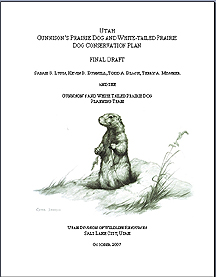Utah Gunnison's And White-Tailed Prairie Dog Conservation Plan
In 2006, the Utah Division of Wildlife Resources (UDWR) entered into a cooperative agreement with Utah’s Community-Based Conservation Program (CBCP) to have CBCP staff coordinate and facilitate the development of a statewide conservation plan for Gunnison’s and white-tailed prairie dogs. Across their range, both Gunnison’s and white-tailed prairie dogs have declined in number and distribution due to impacts from plague, habitat conversion, and habitat disturbance. As a result, environmental groups have petitioned the U.S. Fish and Wildlife Service (USFWS) to list these species on the Endangered Species Act (ESA). Utah, along with several other western states, is developing a Conservation Plan for these species in order to help preclude the need for their listing on the ESA.
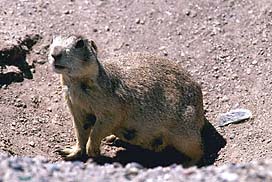
Gunnison's prairie dog
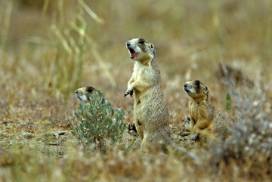
White-tailed prairie dog
The Draft Utah Gunnison's Prairie Dog and White-tailed Prairie Dog Conservation Plan is now available for review and comment. Download or view a PDF of the Draft Plan.
Please send comments on the Draft Plan to plancomments@aggiemail.usu.edu.
Ecology and Life History
| Gunnison's Prairie Dog | White-tailed Prairie Dog |
|---|---|
| Darker than WTPD and Utah Prairie Dog (UPD); no facial pattern. | Distinguished by white-tipped tail and distinct facial markings. |
| Require deep, well-drained soil. | Require deep, well-drained soil. |
| Generally inhabit flat terrain. | Generally inhabit flat to gently rolling terrain. |
| Populations can fluctuate widely from year to year. | Populations have been reported to fluctuate by >50% between consecutive years. |
| Feed primarily on grasses and forbs—switch to seeds. in the fall | Feed on grasses when available and forbs, shrubs, and seed heads in early spring and late fall. |
| Obtain water from plants—population and survival correlated to plant moisture. | Obtain water from plants—moist vegetation crucial to survival. |
| Hibernate or aestivate when metabolically stressed. | Hibernate or aestivate when metabolically stressed. |
| Emerge from burrows from February-late April. | Males emerge from burrows in mid-February to early March; females emerge 2-3 weeks later |
| Females are sexually receptive for a single day and may mate with multiple males. Breeding strategy varies (monogamy to polyandry) with resource availability and population density. | Females are sexually receptive for a single day and may mate with multiple males. |
| Pups emerge between late May and early July. | Breeding season lasts 2-3 weeks. Pups emerge from burrows between mid-May and early June. |
| Have a complex social system where colonies are subdivided into social groups with defined territories. The structure of social groups varies with resource availability. | Social system is characterized by groups of related females and their young with little time spent in maintaining territories or social systems. |
| Colonies are extensive and vary from densely clustered burrows to scattered, isolated ones. | One of the least colonial prairie dog species. Colonize in irregular patterns across the landscape. |
The range of GPDs in Utah encompasses parts of San Juan> and Grand counties. The species range extends into parts of Colorado, Arizona, and New Mexico. In Utah, white-tailed prairie dogs occur in Rich, Summit>, Daggett, Uintah, Duchesne, Carbon, Emery, and Grand ounties. The species range extends into parts of Wyoming, Colorado, and Montana.
To learn more about GPDs and WTPDs, please read the Draft Utah Gunnison’s and White-tailed Prairie Dog Conservation Plan.
Keystone Species Status

Akeystone species is a species that has a disproportionate effect on its environment relative to its abundance. Such an organism plays a role in its ecosystem that is analogous to the role of a keystone in an arch. While the keystone feels the least pressure of any of the stones in an arch, the arch still collapses without it. Similarly, an ecosystem may experience a dramatic shift if a keystone species is removed, even though that species was a small part of the ecosystem by measures of biomass or productivity. Both GPDs and WTPDs are recognized as keystone species because their burrowing activities and status as a prey species modify the grassland and shrub-steppe ecosystems in which they live.
The grazing and burrowing activities of GPDs and WTPDs create unique habitats within their grassland ecosystem, and their colonies represent distinct patches of vegetation structure and composition relative to the surrounding landscape. The presence of GPDs increases habitat heterogeneity (variability) at large spatial scales and their burrows provide structural habitat for burrowing owls (Athene cunicularia) and various small mammals. Measuring vertebrate species diversity, researchers have recorded 16 reptile, 23 bird, and 16 mammal species on GPD towns. WTPD colonies provide habitat for many other organisms, including the endangered black-footed ferret (Mustela nigripes), mountain plover (Charadrius montanus), burrowing owl, and the tiger salamander (Abystoma tigrinum).
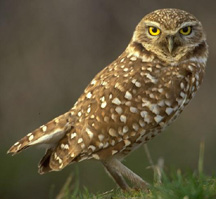

GPDs and WTPDs also serve as prey for a number of predators. GPDs are food for ferruginous hawk (Buteo regalis), red-tailed hawk (Buteo jamaciensis), golden eagle (Aquila chrysaetos), and bald eagle (Haliaeetus leucocephalus). WTPDs serve as prey for badger (Taxidea taxus), golden eagle, ferruginous hawk, bobcat (Felis rufus), coyote (Canis latrans), long-tailed weasel (Mustela frenata), prairie falcon (Falco mexicanus), kit fox (Vulpes macrotis), and black-footed ferret.
Given this high degree of association between GPDs and WTPDs and other species, and the impacts of GPD and WTPD burrowing activity on the areas they inhabit, the status of GPDs and WTPDs may serve as one indication of the overall health of shrub-steppe and grassland ecosystems.
To learn more about GPDs, WTPDs and their status as keystone species, please read the Draft Utah Gunnison’s and White-tailed Prairie Dog Conservation Plan.
Legal Status
In Utah, GPDs and WTPDs are designated as a non-game mammal under Rule 657-19-2. Utah law and administrative rules protect both species from unlawful possession, transportation, destruction, and harm. Both species are listed on the Utah Sensitive Species List and are included in the Utah Comprehensive Wildlife Conservation Strategy as Tier II species (Utah Species of Concern).
Utah State Statutes (4-23-3, UCA) classify prairie dogs as “depredating animals”. This section of law is administered by the Utah Department of Agriculture and Food. Only licensed applicators are permitted to use rodenticides to control prairie dogs. In Utah, certification consists of a written exam and applicators are required to keep written records of their activities, including the purpose for which it was used.
In 2002 (WTPD) and 2004 (GPD), petitions were filed to list both species under the Endangered Species Act. Both petitions cited habitat loss/conversion, shooting, disease, a history of eradication efforts, and inadequate federal and state regulatory mechanisms as threats to long-term viability of these species. The USFWS produced negative 90-day findings for both petitions.
For additional information about the legal status of GPDs and WTPDs in Utah, please read the Draft Utah Gunnison’s and White-tailed Prairie Dog Conservation Plan.
Conservation and Management Issues
Issues facing GPDs and WTPDs in Utah can be grouped into the following categories, which correspond to the 5 USFWS Listing Factors:
- The present or threatened destruction, modification, or curtailment of its habitat or range
- Agricultural land conversion
- Urbanization
- Oil and gas development
- Livestock grazing
- Altered fire regimes
- Over-utilization for commercial, recreational, scientific, or educational purposes
- Shooting
- Poisoning
- Disease or predation
- Sylvatic plague
- Tularemia
- Predation
- Inadequacy of existing regulatory mechanisms
- Other natural or man-made factors affecting its continued existence
- Poisoning
- Drought
- Climate change
Management Goal, Objectives, and Strategies
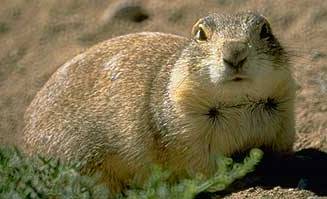 Upon completion, the goal of the Utah Gunnison’s and White-tailed Prairie Conservation Plan is to conserve GPD and WTPD populations and sage-steppe and prairie scrub ecosystems they inhabit in the state of Utah. Although this Conservation Plan focuses on GPD and WTPD conservation, it is recognized that, because of their keystone species status, factors impacting GPDs and WTPDs likely also impact associated species; conservation actions, when applicable, will also be designed to benefit associated species.
Upon completion, the goal of the Utah Gunnison’s and White-tailed Prairie Conservation Plan is to conserve GPD and WTPD populations and sage-steppe and prairie scrub ecosystems they inhabit in the state of Utah. Although this Conservation Plan focuses on GPD and WTPD conservation, it is recognized that, because of their keystone species status, factors impacting GPDs and WTPDs likely also impact associated species; conservation actions, when applicable, will also be designed to benefit associated species.
Several conservation objectives have been established for GPDs and WTPDs in Utah. For each conservation objective, one or more strategies and associated actions have been developed. Implementation of these strategies and their associated actions is designed to enhance the viability of GPD and WTPD populations in Utah and to abate threats impacting these species and their habitats. For a complete list of objectives, strategies, and action steps, please read the Draft Utah Gunnison’s and White-tailed Prairie Conservation Plan.


